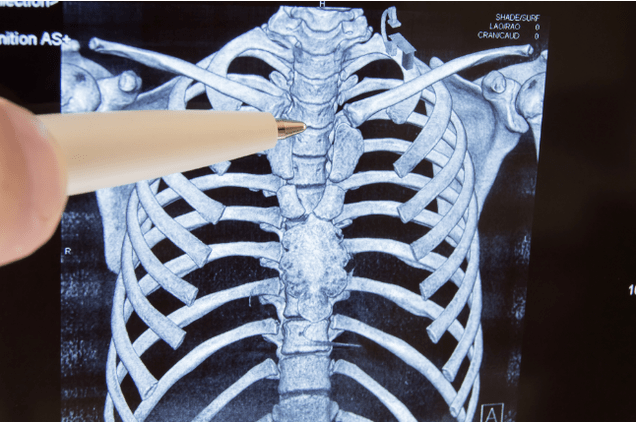Osteochondrosis is a disease of the spine in which the intervertebral discs (and subsequently the body of the vertebrae, joints and ligaments) lose their ability to function normal.

The cause of osteochondrosis is currently considered a set of factors that affect the spine during a person's life.An additional risk of osteochondrosis develops the resulting injuries to the spine as well as the interruption of the posture.Some patients note the relationship of the onset of the disease and hypothermia.
It is practically customary to consider
- cervical osteochondrosis,
- Osteochondrosis of the chest and
- Lumbar spine.
It should be noted that osteochondrosis is common, characterized by damage to several parts of the spine at a time.
The most common are cervical and thoracic forms, since these spine departments are the subject of the largest loads.
Symptoms of osteochondrosis
With osteochondrosis, patients describe symptoms such as:
- Paroxysmal or firing spinal pain affected by osteochondrosis;
- increased pain after exercise as well as in the morning;
- The pain can be applied to the neck, arm or legs, as well as in the chest;
- Feeling of crunching when twisting.
Osteochondrosis is also characterized by symptoms of neurological nature from the affected side:
- partial disorders of the movement (paresis);
- unpleasant sensations in the form of a guy, numbness (paresthesia);
- Palpation determines the muscle tension corresponding to the affected department.
The disease begins and develops gradually, not abruptly.
It is necessary to distinguish osteochondrosis of the spine from coronary heart disease (with coronary heart disease, the appearance of pain is not associated with physical activity, but is due to side factors: cough, prolonged seat).
Treatment
The same symptoms can be signs of various diseases and the disease may not occur according to the textbook.Do not try to treat yourself - consult your doctor.
Osteochondrosis therapy always requires an integrated approach.In the treatment, the attention of doctors such as therapist, rheumatologist, neuropathologist and physiotherapist is required.Treatment of osteochondrosis of the spine depends on the location, the prevailing symptoms and the severity of the disease.
Conservative therapy is aimed at eliminating the symptoms of pain as well as to restore normal spinal function.
Rational nutrition for osteochondrosis greatly facilitates the patient's condition and promotes more effective therapy.Read more about the principles of osteochondrosis nutrition in our separate article.
About 10% of patients were sent for surgical treatment.The absolute indicator of surgery in osteochondrosis is the appearance of neurological disorders due to the pinching of the spinal cord itself.
Additional indicators for surgical treatment of osteochondrosis are considered as the following:
- prolonged periodic attacks of pain;
- increased mobility and suspicion of spinal instability;
- inefficiency of drug therapy for 3 months;
- Pronounced disorders that prevent the patient from leading a full life.
Methods of surgical treatment
Surgical interventions with minimal trauma:
- Preparations for enzyme preparations are used in the intervertebral disc after firing for the purpose of scars of the nucleus and the fibrous ring of the disc.
- Puncture Nucleotomy - interrogation of the intervertebral disc to remove some of the poison.
- Disha Denvarva - a drug is introduced into the intervertebral disc, which blocks the sensitivity of the nerve endings.
The other methods for surgical treatment of osteochondrosis of the spine are less gentle.These include:
- Complete or partial removal of the intervertebral disc or its hernia - this surgery is aimed at reducing the symptoms of compression.
- Prosthetics of the intervertebral discs - The main task is to fix the affected vertebrae segments.
Surgical methods for treating osteochondrosis of the spine provide a prognosis for complete recovery for only 50% of cases.
With timely treatment, life prognosis is almost always favorable, but the prognosis for working capacity may be different due to a number of factors.
Osteochondrosis exercises
Exercise 1.
Tilt your head forward while pressing your forehead with woven fingers.Press your fingers closely on the back of the head and whiskey - left, right.The head counteracts the pressure of the hands and hands - the pressure of the head.Spend 10 seconds.For every movement.
Exercise 2.
Place the tips of four fingers on the forehead opposite each other, carefully press on the skin with the entire surface of the palm and with soft grip moves it for 10-40 seconds.We can do the same stretch in the temple in a longitudinal and transverse direction.The same - on the ear - to stretch it in all directions, especially the lobes.That.You improve blood circulation in areas rich in biologically active points.
Exercise 3.
This type of massage improves blood flow to jugular veins and brain nutrition improves.Sit exactly, your back is right.Slowly bring your head back, helping with your hand, pushing your chin back and up.You can slowly rotate your head a little left and right.Stay in this position for about a minute.10 seconds are enough for children.
Exercise 4.
This exercise improves the functioning of the cervical nerve plexus.Sit exactly, your back is right.Slowly tilt your head forward, trying to touch your chin on your chest.Place the tissue fingers on the back of the head, press forward and up, lifting the back of the head.Sit for about a minute.After 15 minutes you can repeat.
Exercise 5.
Raise your shoulders up, trying to bring it to your ears, smaller, free, faster -in 15 seconds.Now alternatively - one arm up, the other is down, also 15 seconds.Pull the cervical spine with your palms.






















